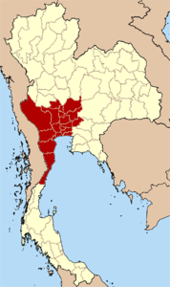Central Thailand
Central Thailand ( Thai ภาค กลาง , RTGS Phak Klang , pronounced: [ pʰâːk klaːŋ ]) is a region in Thailand which is determined by the basin of the Mae Nam Chao Phraya ( Chao Phraya River ). The Chao Phraya is formed by the confluence of the Mae Nam Nan ( Nan River ), Mae Nam Ping ( Ping River ), Mae Nam Wang ( Wang River ) and Mae Nam Yom ( Yom River ) rivers at Nakhon Sawan , in Nakhon Sawan is also the assumed border to the north. To the south, the central region extends to the province of Prachuap Khiri Khan on the Malay Peninsula . Here Thailand only forms a narrow strip of land between Burma and the Gulf of Thailand .
To the northeast, the region is bounded by the Phetchabun Mountains , from where the Khorat plateau begins. In the west, the border with Myanmar is formed by the rugged Tenasserim Mountains .
To the north , Central Thailand gradually turns into an increasingly hilly landscape. From central Thailand, the kingdom of Ayutthaya determined the fate of Siam for over 400 years . Political and economic power is still concentrated in the region today. So it is hardly surprising that the central region is rich in historical sites. In addition to the numerous important buildings in today's capital Bangkok and the re-established old capital Ayutthaya , these are Lop Buri and Nakhon Pathom .
The standard Thai language is based on the dialects of the central region. In the other major regions, varieties that differ significantly from this are sometimes spoken of. The attempt to bring the culture and way of life of the ethnic minorities and regional groups on the periphery of Thailand into line with that of the central region is known as Thaiization .
administration
Central Thailand - together with the east, which is not always treated separately - is divided into 26 provinces ( Changwat ) . Especially for statistical overviews, the region is further divided into four groups:
- Bangkok and neighboring provinces: Bangkok , Nakhon Pathom , Nonthaburi , Pathum Thani , Samut Prakan , Samut Sakhon
- Lower central region: Ang Thong , Ayutthaya , Chai Nat , Lop Buri , Saraburi , Sing Buri
- Western region: Kanchanaburi , Phetchaburi , Prachuap Khiri Khan , Ratchaburi , Samut Songkhram , Suphan Buri
- Eastern region: Chachoengsao , Chanthaburi , Chonburi , Nakhon Nayok , Rayong , Prachin Buri , Sa Kaeo , Trat
The eastern region is often recorded as an independent region, but the provinces included in it change in such a way that one cannot see a uniform line. It is not an administrative, but rather a geographical and statistical classification.
According to the six-region model, as used by the National Geographic Committee, the eastern and western regions do not belong to central Thailand, but seven provinces in the lower north ( Kamphaeng Phet , Nakhon Sawan , Phetchabun , Phichit , Phitsanulok , Sukhothai , Uthai Thani ). Historically and culturally, these areas belong more to central than to northern Thailand, as they never belonged to the northern Thai kingdom of Lan Na , but to the Siamese kingdoms of Sukhothai or Ayutthaya and central Thai dialects are spoken here and not the northern Thai Kham Müang .
economy
The central and eastern regions are rich in agricultural products such as rice , sugar cane , tapioca , gum and a wide variety of fruits. The Chao Phraya irrigates the central lowlands, which is one of the most important rice-growing areas in the world, and feeds an extensive network of canals. In the past, the sewer network was not only intended for irrigation, but also for transport. This function is no longer necessary today.
Animal husbandry and fishing also play a role, particularly in the east . The eastern provinces are also rich in natural gas resources , so the Thai government decided in the 1990s to establish a regional growth center here. For this purpose, the so-called Eastern Seaboard Development Program was launched, which was intended to attract foreign trade-oriented companies on the one hand and the petrochemical industry on the other . For this purpose, two larger port complexes were built at Laem Chabang , near Si Racha ( Chonburi Province ), and at Map Ta Phut ( Rayong Province ). Laem Chabang is primarily suitable for light industry , while Mapthaphut is intended for the chemical industry .
literature
- Wolf Donner : Thailand . Darmstadt: Scientific Book Society 1986.


